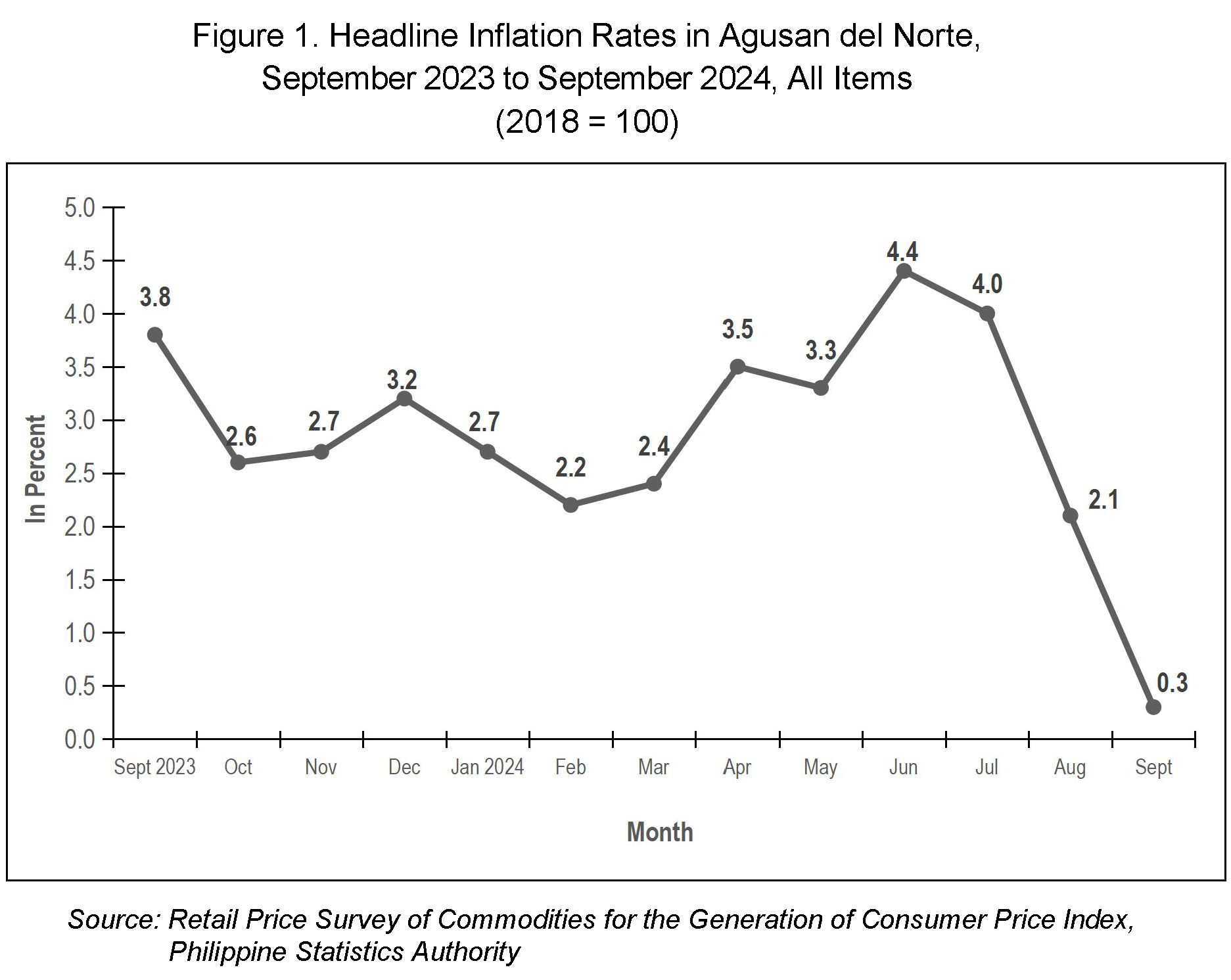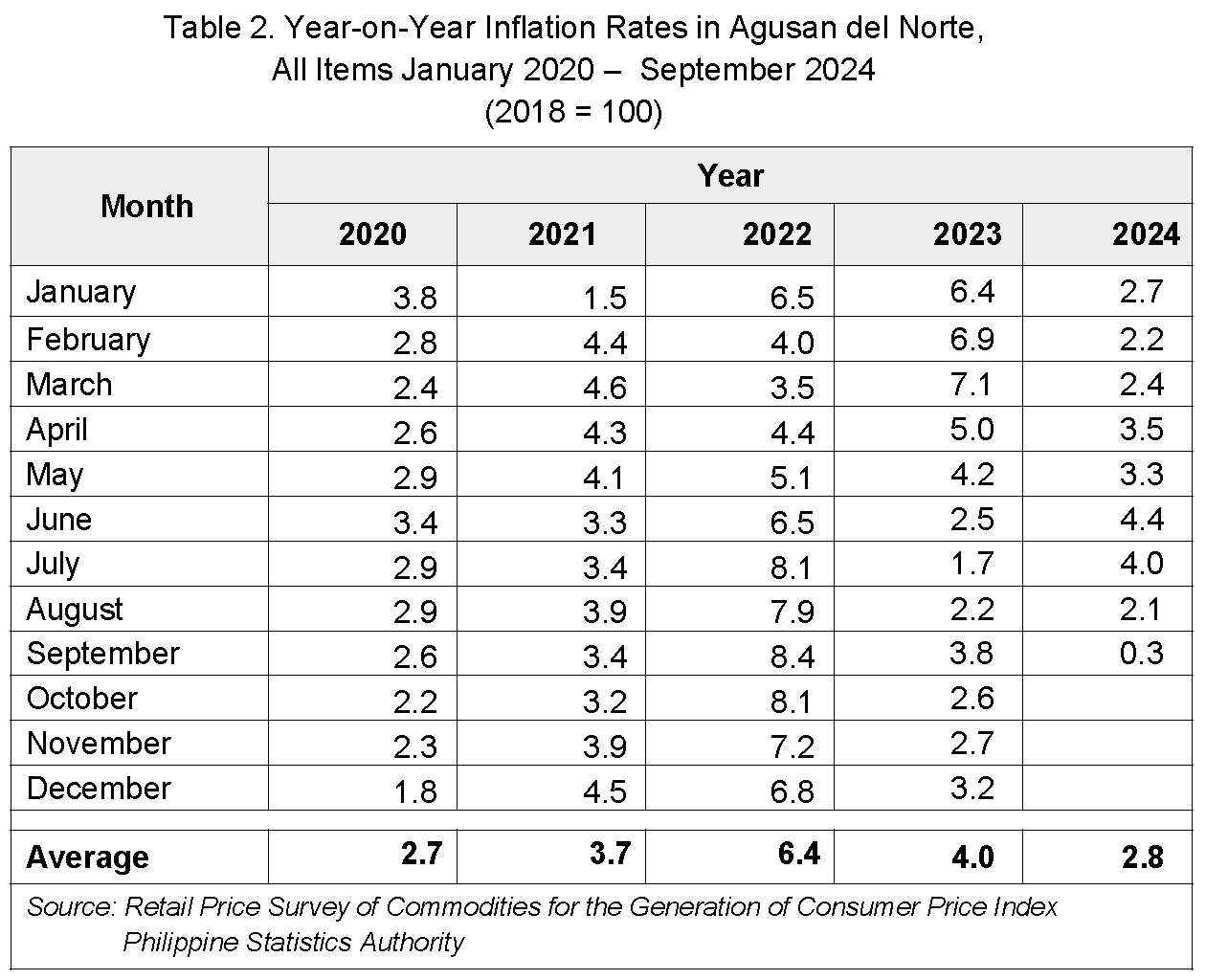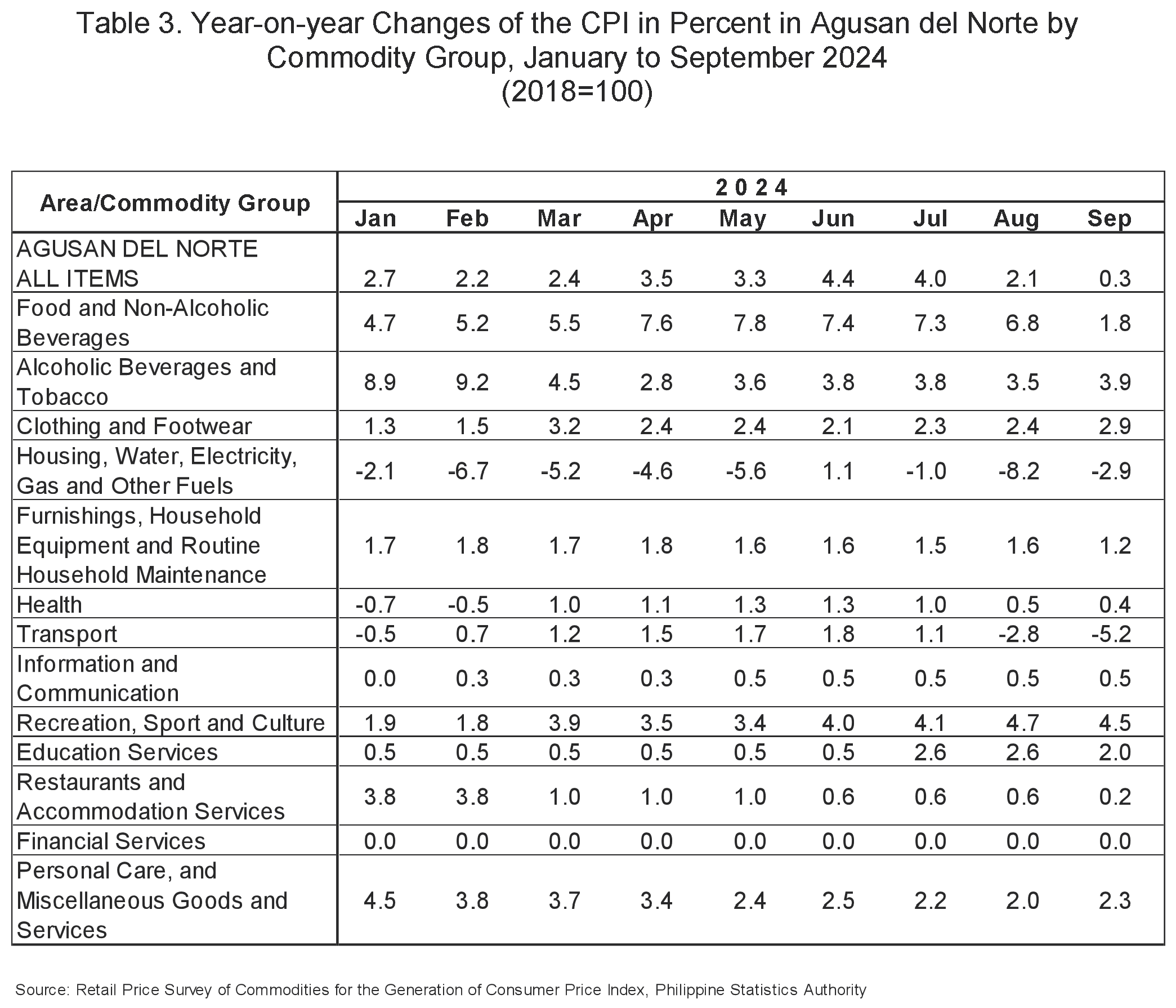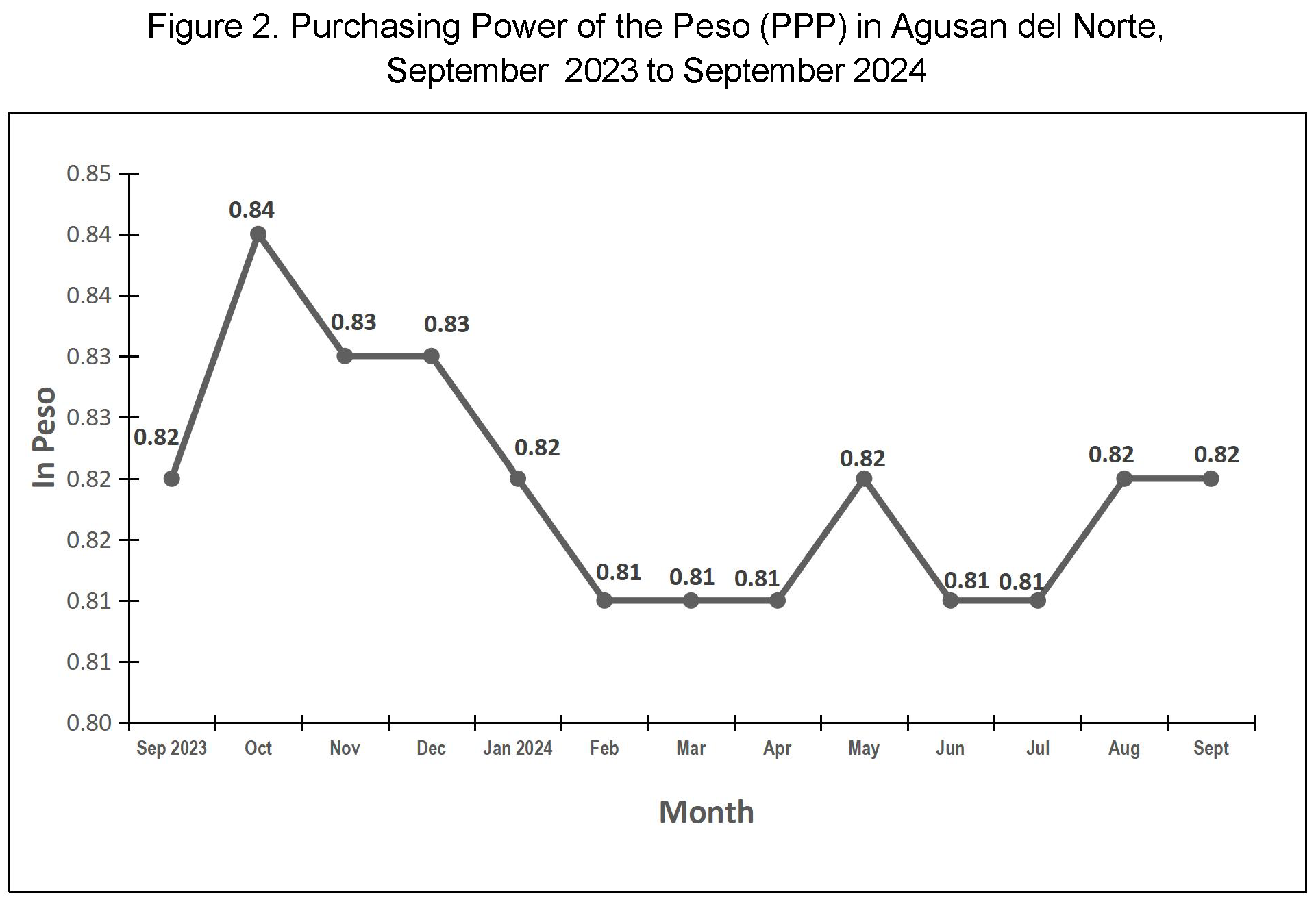
The headline inflation rate in Agusan del Norte further decreased to 0.3% in September 2024.
In September 2024, the inflation rate in Agusan del Norte province further decreased to 0.3 percent from its 2.1 percent inflation recorded in August 2024. This indicates a decline of 1.8 percentage points compared to the inflation rate in August 2024, and 3.5 percentage points compared to the inflation rate in September 2023, which was reported at 3.8 percent.

Major Contributors to the September 2024 Inflation
The following groups mainly contributed to this month’s inflation. These are:
1. Food and Non-Alcoholic Beverages; the inflation rate of this category decreased to 1.8 percent from 6.8 percent in August 2024. This specific group made a significant contribution of approximately 316.8 percent to the total inflation for the month.
2. Personal Care, Miscellaneous Goods and Services; this category ranked second on the list, exhibiting an inflation rate of 2.3 percent, surpassing the
2.0 percent inflation rate noted in August 2024. This sector accounted for approximately 36.0 percent of the total inflation in Agusan del Norte.
3. Clothing and Footwear; this category achieved the third position in the ranking, indicating a 2.9 percent inflation rate in September 2024, representing a slight increase of 0.5 percentage points compared to the 2.4 percent inflation recorded in August 2024. This particular category accounted for approximately 30.4 percent of the total inflation observed during this period.

Major Contributor to the Year-on-Year Inflation Trend
Among the thirteen (13) groups of commodities, the following groups have made a substantial contribution to the reduction in inflation. These are the following:
1) Food and Non-Alcoholic Beverages; this category witnessed a substantial decline in prices, leading to a significant decrease in inflation to 1.8 percent in September 2024 from 6.8 percent in August 2024. This particular group notably accounted for 89.6 percent of the overall reduced inflation rate.
2) Transport; this particular sector ranked second in terms of its impact on the inflation trend, with its inflation rate decreasing from -2.8 percent in August 2024 to -5.2 percent this month. The downturn in the prices of fuels and lubricants for personal transport equipment was the primary catalyst behind this reduction. This commodity group accounted for approximately 8.5 percent of the overall inflation trend.
3) Restaurants and Accommodation Services; this sector attained the third position, with its inflation rate diminishing to 0.2 percent in September 2024 from 0.6 percent in August 2024, contributing approximately 0.9 percent to the inflation trend.
Inflation Rate by Commodity Group

Food Alone Inflation
In September 2024, the province experienced a notable decline in the food inflation rate, plummeting to 1.9 percent from 7.2 percent in August 2024. When compared to the inflation rate recorded in the corresponding month of the previous year, this month's inflation has decreased by 5.6 percentage points from its reported rate of 7.5 percent in September 2023. The key factors contributing to the inflation trend in the food category are as follows:
1) Cereals and cereal products; This particular category wield a significant influence on the inflation rate within the realm of food. A noteworthy decline in inflation was noted, transitioning from 21.6 percent in August 2024 to 4.8 percent in September 2024. The decrease in the annual growth rate of rice played a pivotal role in this reduction, as inflation rates dwindled to 4.9 percent from the preceding month's figures of 28.4 percent. Furthermore, there was a marginal decrease in the inflation rate of corn from 7.1 percent in August 2024 to 6.7 percent in the current month. This specific food group contributed approximately 92.7 percent to the prevailing food inflation trend in the province.
2) Vegetables, tubers, plantains, cooking bananas and pulses (ND) secured the second position in the ranking. This food category witnessed a significant decrease in inflation in September 2024, plummeting to -9.7 percent from the -2.0 percent noted in August of the same year. The decline in prices of vegetables, particularly tomatoes, played a pivotal role in the reduced inflation within this specific group. Moreover, this particular food category contributed to a 6.8 percent share of the overall food inflation trend.
3) Ready-made food and other food products n.e.c were ranked third, displaying a notable decrease in inflation of 3.6 percent this month compared to 4.5 percent in August 2024. The drop in the average prices of specific seasonings, particularly ginger, played a pivotal role in the decrease of inflation within this food category. This sector contributed approximately 0.4 percent to the overall food inflation trend for September 2024.

The Purchasing Power of the Peso (PPP) in Agusan del Norte has remained stable at Php 0.82 in August 2024. This indicates that the Philippine Peso has exhibited resilience in preserving its purchasing power within the province.
To expound further, the value of a peso in 2018 has experienced a devaluation to 82 centavos by August 2024. Consequently, it now requires Php121.8 to acquire equivalent goods and services that were priced at Php100.00 in 2018.
TECHNICAL NOTES
The Philippine Statistics Authority generates and announces the monthly Consumer Price Index (CPI) based on the nationwide survey of prices for a given basket of goods and services. Two important indicators, the inflation rate and purchasing power of the peso (PPP), are derived from the CPI which are important in monitoring price stability and the value of the country’s currency.
The Consumer Price Index (CPI) is an indicator of the change in the average retail prices of a fixed basket of goods and services commonly purchased by households relative to a base year. It shows how much on the average, prices of goods and services have increased or decreased from a particular reference period known as base year.
Inflation Rate refers to the rate of change in the average prices of goods and services typically purchased by consumers. It is interpreted in terms of declining purchasing power of money.
Disinflation refers to a situation where the general level of prices is increasing but at a decreasing rate.
Deflation refers to a situation where the general level of prices is falling and the rate is below zero percent.
The Purchasing Power of the Peso (PPP) indicates the value of the peso in the period under review as compared to the value of the peso in the base period. It is computed as the reciprocal of the CPI for the period under review multiplied by 100.
Statistical Table refers to the statistical data presenting a reference table for the CPI, and Inflation Rate of each commodity groups and food items that are used for attachments.
Approved by:
(Sgd.) REYNELO S. MAGNO
Chief Statistical Specialist, PSO – Agusan del Norte
Telephone number: (085) 817-3193 / Telefax No.: (085) 225 – 2097 Email address: agusandelnorte@psa.gov.ph

